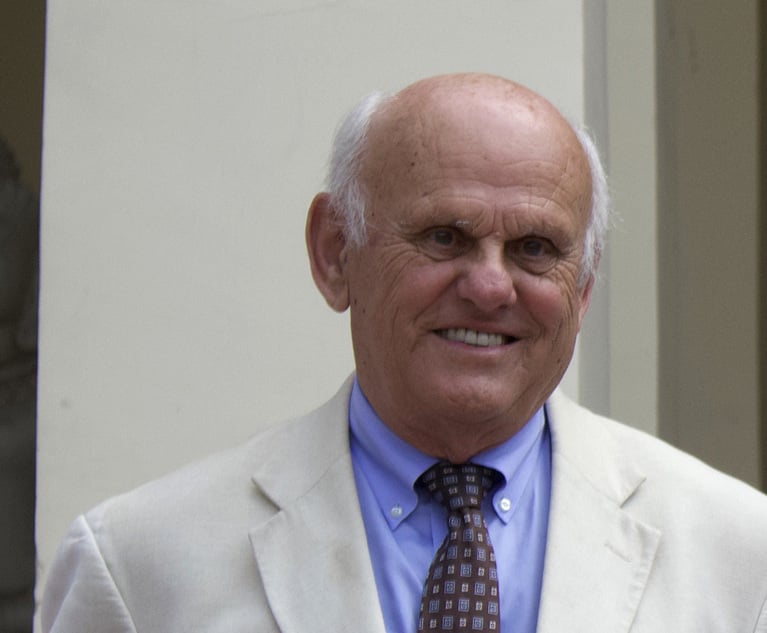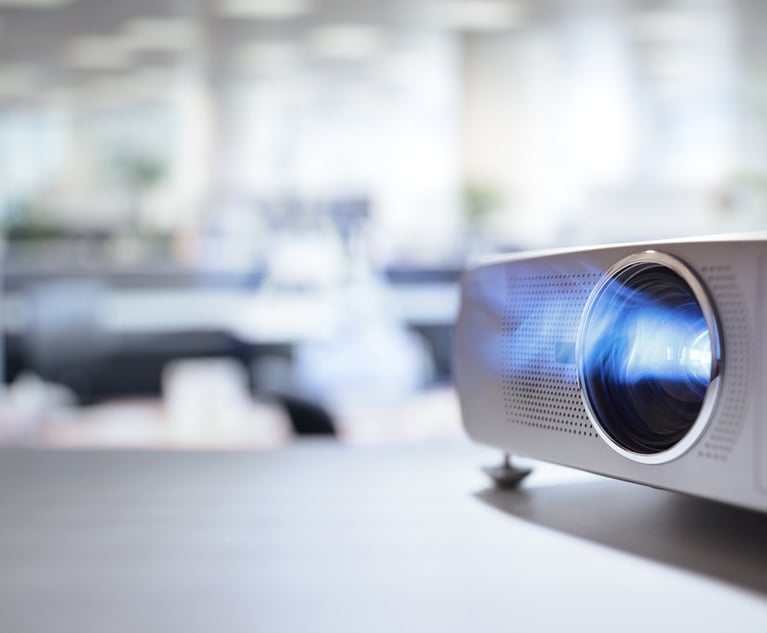BlackBerry Mostly Survives Facebook's and Snap's Section 101 Attack
U.S. District Judge George Wu says it's too early in the litigation to knock out more than just a few of the challenged patent claims.
August 22, 2018 at 07:53 PM
4 minute read
 (Photo: Svetlana Dikhtyareva/Shutterstock.com)
(Photo: Svetlana Dikhtyareva/Shutterstock.com)
BlackBerry Limited has mostly survived an early Section 101 attack on the eligibility of mobile messaging patents it's asserting against Facebook Inc. and Snap Inc.
U.S. District Judge George Wu knocked out claims from one of the seven challenged patents but otherwise denied Facebook's and Snap's motions to dismiss, albeit without prejudice to raising the motions again later in the case.
“Without more information, the court at this stage cannot conclude as a matter of law that the claims are drawn to patent-ineligible subject matter,” Wu wrote in one part of his 27-page order.
The ruling keeps alive most of a case brought by a Quinn Emanuel Urquhart & Sullivan team led by partner James Asperger. Partners Jordan Jaffe and Ray Zado also argued for BlackBerry at an Aug. 3 hearing.
BlackBerry no longer makes its own mobile phones, but it still holds a trove of mobile technology patents. It asserted them against Facebook and Snap earlier this year, which fired back with motions challenging several as covering “ancient concepts” such as “who gets a message, how it is sent and the manner of notification.”
Specifically, the challenged patents cover displaying an icon that indicates the number of messaging correspondents who've sent unread messages; a system for pushing targeted advertising to a mobile device based on a triggering event; selectively displaying time stamps based on the time elapsed between messages; and using locations services to find nearby social activity.
Only Snap challenged the time stamp patent, U.S. Patent 8,301,713. Paul Hastings partner Yar Chaikovsky argued for Snap that courts, for one example, have been time-stamping documents for centuries and merely doing it on a computer doesn't make it eligible for patenting. Wu agreed that the patent's three independent claims are ineligible, saying they used language that's too broad. “BlackBerry effectively concedes that there are no limits on what constitutes a 'predetermined duration of time'” between messages, Wu wrote.
But Wu turned away the rest of Snap's and Facebook's challenges, relying frequently on the Federal Circuit's recent Core Wireless decision that strengthened eligibility for graphical user interface patents, and its Berkheimer decision that discouraged early resolution of eligibility when factual disputes are in play.
Facebook, represented by a Cooley team led by partner Heidi Keefe, had argued that merely displaying a number on an icon, as with the 8,209,634 message notification patent, is an unprotectable abstract idea. But Wu wrote that displaying “a very particular type of data in a very particular way” is not abstract after Core Wireless.
Facebook argued that the targeted advertising patents, Nos. 8,296,351 and 8,676,929, recited a generic computer server for pushing out content in a conventional manner. Wu said it was too soon to rule on that challenge but wrote in a footnote that if the server does prove to be generic, “legal authority would suggest that at least the independent claims of the '351 Patent are drawn to patent-ineligible concepts.”
Finally, Wu left standing the patents on locating nearby social activity, despite Snap's arguments that military generals have long studied the formation of nearby troops and news companies have reported on automobile traffic patterns. “Snap's examples do not allow for the same level of specific information tailored by location for a particular individual or the ability to adapt the displayed information based on changes in the individual's location,” Wu wrote.
He again sounded a skeptical note, saying that “the issue herein may not be a Section 101 problem at all but, rather, questions as to novelty, obviousness and/or enablement.”
While leaving the vast majority of patent claims intact, Wu dismissed BlackBerry's claim for willful infringement—for the time being eliminating the possibility of treble damages—but granting leave to amend pending discovery.
This content has been archived. It is available through our partners, LexisNexis® and Bloomberg Law.
To view this content, please continue to their sites.
Not a Lexis Subscriber?
Subscribe Now
Not a Bloomberg Law Subscriber?
Subscribe Now
NOT FOR REPRINT
© 2025 ALM Global, LLC, All Rights Reserved. Request academic re-use from www.copyright.com. All other uses, submit a request to [email protected]. For more information visit Asset & Logo Licensing.
You Might Like
View All
'Where Were the Lawyers?' Judge Blocks Trump's Birthright Citizenship Order
3 minute read
Netflix Music Guru Becomes First GC of Startup Helping Independent Artists Monetize Catalogs
2 minute read
K&L Gates Files String of Suits Against Electronics Manufacturer's Competitors, Brightness Misrepresentations
3 minute read
Holland & Knight Hires Former Davis Wright Tremaine Managing Partner in Seattle
3 minute readTrending Stories
Who Got The Work
J. Brugh Lower of Gibbons has entered an appearance for industrial equipment supplier Devco Corporation in a pending trademark infringement lawsuit. The suit, accusing the defendant of selling knock-off Graco products, was filed Dec. 18 in New Jersey District Court by Rivkin Radler on behalf of Graco Inc. and Graco Minnesota. The case, assigned to U.S. District Judge Zahid N. Quraishi, is 3:24-cv-11294, Graco Inc. et al v. Devco Corporation.
Who Got The Work
Rebecca Maller-Stein and Kent A. Yalowitz of Arnold & Porter Kaye Scholer have entered their appearances for Hanaco Venture Capital and its executives, Lior Prosor and David Frankel, in a pending securities lawsuit. The action, filed on Dec. 24 in New York Southern District Court by Zell, Aron & Co. on behalf of Goldeneye Advisors, accuses the defendants of negligently and fraudulently managing the plaintiff's $1 million investment. The case, assigned to U.S. District Judge Vernon S. Broderick, is 1:24-cv-09918, Goldeneye Advisors, LLC v. Hanaco Venture Capital, Ltd. et al.
Who Got The Work
Attorneys from A&O Shearman has stepped in as defense counsel for Toronto-Dominion Bank and other defendants in a pending securities class action. The suit, filed Dec. 11 in New York Southern District Court by Bleichmar Fonti & Auld, accuses the defendants of concealing the bank's 'pervasive' deficiencies in regards to its compliance with the Bank Secrecy Act and the quality of its anti-money laundering controls. The case, assigned to U.S. District Judge Arun Subramanian, is 1:24-cv-09445, Gonzalez v. The Toronto-Dominion Bank et al.
Who Got The Work
Crown Castle International, a Pennsylvania company providing shared communications infrastructure, has turned to Luke D. Wolf of Gordon Rees Scully Mansukhani to fend off a pending breach-of-contract lawsuit. The court action, filed Nov. 25 in Michigan Eastern District Court by Hooper Hathaway PC on behalf of The Town Residences LLC, accuses Crown Castle of failing to transfer approximately $30,000 in utility payments from T-Mobile in breach of a roof-top lease and assignment agreement. The case, assigned to U.S. District Judge Susan K. Declercq, is 2:24-cv-13131, The Town Residences LLC v. T-Mobile US, Inc. et al.
Who Got The Work
Wilfred P. Coronato and Daniel M. Schwartz of McCarter & English have stepped in as defense counsel to Electrolux Home Products Inc. in a pending product liability lawsuit. The court action, filed Nov. 26 in New York Eastern District Court by Poulos Lopiccolo PC and Nagel Rice LLP on behalf of David Stern, alleges that the defendant's refrigerators’ drawers and shelving repeatedly break and fall apart within months after purchase. The case, assigned to U.S. District Judge Joan M. Azrack, is 2:24-cv-08204, Stern v. Electrolux Home Products, Inc.
Featured Firms
Law Offices of Gary Martin Hays & Associates, P.C.
(470) 294-1674
Law Offices of Mark E. Salomone
(857) 444-6468
Smith & Hassler
(713) 739-1250






